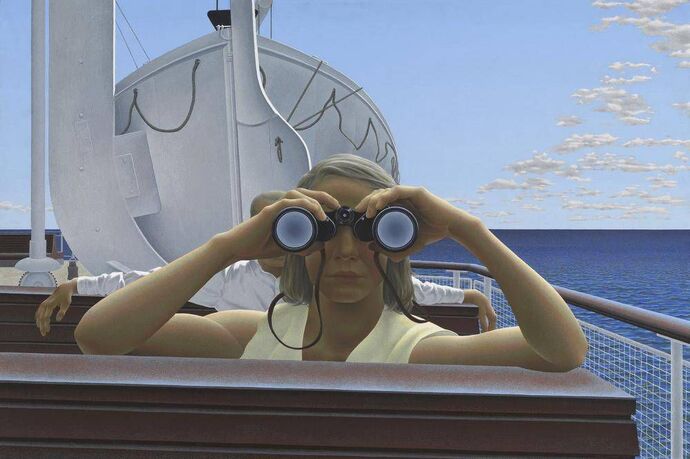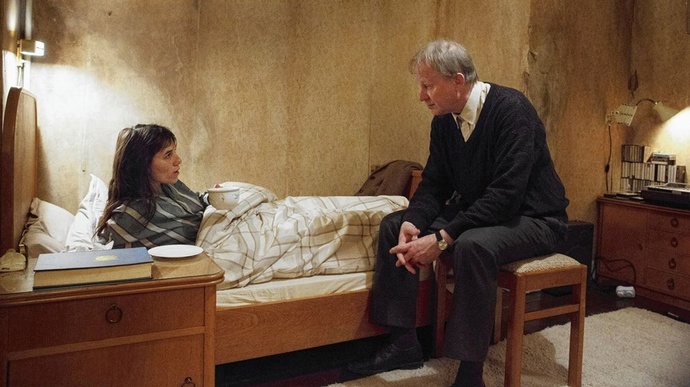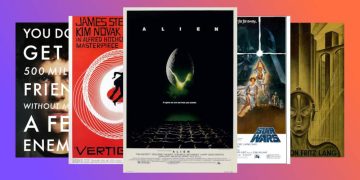When one artform meets another, magical things can happen—and that's especially true when a movie pays homage to a famous painting by composing a scene in almost the exact same way.
Whether it's a subtle nod to a masterpiece or entire feature dedicated to a painter's masterpieces, here are several films that recreated the look of famous paintings to infuse deeper meanings.
10. The Nightmare in Gothic (1986)

Gothic is far from the best movie ever made, but critics can agree that its striking (and gruesome) imagery is what makes it stand out.
A weird, lowbrow horror that caters to cult fans, Gothic reimagines the story of the Shelleys' visit to Lord Byron and how Frankenstein was first written in 1818. So, basically, it's about how the genre was born.
Ken Russell's hallucinatory British horror wasn't exactly covert in its pastiche reference to Henry Fuseli's painting The Nightmare (1781). In fact, it was even on the movie poster!
With the painting considered a Gothic classic, of course it had to make an appearance in a film literally titled Gothic!
9. To Prince Edward Island in Moonrise Kingdom (2012)

Like every Wes Anderson film, you could pause Moonrise Kingdom at any point and be greeted with a picture-perfect frame. The splendid symmetry and precise color palettes of his films result in cinematic experiences that feel like two-hour-long moving paintings.
So, why not chuck a real painting in there? Moonrise Kingdom is a pretty, pastel-colored coming-of-age tale in which two kids decide to run away and live in an island cove together.
The most common screengrab you'll find of Moonrise Kingdom shows Suzy (Kara Hayward) holding a pair of binoculars. The lush horizon perfectly parallels the frame she's stood on, pointing her gaze straight at us.
The scene echoes that of Alex Colville's To Prince Edward Island (1965), a pointillist piece that was popular in the 60s and depicted another little girl watching us as the sea rolls behind her.
8. Napoleon Crossing the Alps in Marie Antoinette (2006)

Sofia Coppola clearly did a lot of research on the aesthetics of 18th century France for her movie Mary Antoinette. Then, she mixed it with her usual trademark style to bring us a gorgeous, feminist romance-drama.
Kirsten Dunst stars as the final Queen of France before the French Revolution of 1789, leading a lavish existence that was terrible for the economy but brilliant to capture cinematically!
Although Napoleon Bonaparte isn't in the movie, Jamie Dornan does appear on horseback as Count Fersen. The white horse, red cape, bicorne hat, and battle-ready posture are remarkably similar to Napoleon Crossing the Alps by Jacques-Louis David (1801).
Sofia Coppola clearly has an artistic mind that considers every single detail of every single frame—especially this one.
7. The Dying Artist in Nymphomaniac (2013)

With a title like Nymphomaniac, you probably wouldn't expect it to reference a classic Polish painting from the Victorian era.
The Dying Artist by Zygmunt Andrychiewicz (1901) illustrates the somber scene of an artist sleeping in his bed, unaware that death sits beside him. The fact that the skeleton-man is playing the violin makes it sort of hauntingly beautiful.
While the painting isn't exactly erotica material, writer/director Lars von Trier successfully incorporated it into his controversial two-part movie. It's a subtle reference, but certainly visible enough to art fanatics.
Nymphomaniac is basically one big morality play, with Joe (Charlotte Gainsbourg) mirroring the dying artist and Seligman (Stellan Skarsgård) the immoral/mortal harbinger of darkness beside her bed.
6. Spoliarium in Heneral Luna (2015)

Spoliarium (1884) is the largest painting in the Philippines, towering over all with its size: 13.85 feet tall by 25.2 feet wide.
A Romanticist oil canvas by Filipino painter Juan Luna, it served as an icon of Filipino nationalism, showing broken bodies being dragged across the bloodied, stone floor.
Allan Paule plays the said painter in Heneral Luna, but that's not actually what the film is about. Director Jerrold Tarog focuses on the history of General Antonio Luna (John Arcilla), who was a key leader in the Philippine-American War.
The General's brother, Juan Luna, may only play a small part in the film, but his influence flows throughout. Behind the camera, cinematographer Pong Ignacio drew inspiration from many of Luna's real paintings as well as Stanley Kubrick's anti-war flick Paths of Glory.
Western audiences might not have heard of Heneral Luna, but it's one of the most expensive Filipino epic films ever made.
5. Wheatfield With Crows in Dreams (1990)

It was only time before Vincent van Gogh would show up in this article. Not only is Van Gogh one of the most famous painters in history, his visual style is amazingly fun to explore in films.
Legendary Japanese filmmaker Akira Kurosawa—best known for Rashomon and Seven Samurai—also has a passion for painting, hence his creation of a film as artistically whimsical as Dreams.
Dreams is made up of eight vignettes, each one reconstructing one of his many real dreams that Kurosawa repeatedly had.
The fifth part is titled Crows as a direct reference to Van Gogh's 1890 post-impressionist landscape Wheatfield With Crows. In it, an art student stumbles into the world of Van Gogh himself, played (unexpectedly) by Martin Scorsese.
4. Saturn Devouring His Son in Pan's Labyrinth (2006)

The Black Paintings was the name of Francisco Goya's fourteen-part series, painted directly onto the walls of his home in Madrid. Having lived through a war-torn country and severe illness, Goya translated his pessimism into famously eerie art pieces.
One of the most disturbing ones was called Saturn Devouring His Son (1819–1823), which shows the Titan Cronus literally eating one of his offspring. Yeah, he got pretty dark at times.
Guillermo del Toro is a champion of the dark fantasy genre, with most of his strange creatures portrayed by Doug Jones. The Pale Man from Pan's Labyrinth is particularly frightening, void of all features except saggy, oversized skin that drips from his bones.
At one point, the Pale Man bites the head of a nearby fairy. Del Toro admitted that this scene was inspired by Goya, with the Pale Man coming "straight from Goya's painting of Saturn Devouring His Son."
3. Nighthawks in Pennies From Heaven (1981)

It doesn't look like much is happening in Nighthawks (1942), but it remains one of the most recognizable oil paintings around: four people in the window of a late-night diner.
Herbert Ross pays homage to the American art classic in his musical drama Pennies From Heaven, starring Steve Martin. The film opens to Chicago in 1934, with so many of its scenes and settings based off post-war, Depression-era memorabilia—photographs, paintings, books, etc.
The most obvious one is certainly Nighthawks, with Steve Martin sitting in a fedora hat beside Bernadette Peters. This isn't the only Edward Hopper painting to appear on this list, by the way!
2. Edward Hopper Paintings in Shirley: Visions of Reality (2013)

Shirley: Visions of Reality doesn't just feature one Edward Hopper painting. It features basically his entire canon.
The modern artist was known for his poignant use of realism and block coloring, which experimental filmmaker/architect/artist Gustav Deutsch brought to life. His multiple disciplines enabled Deutsch to animate Hopper's paintings in ways Hollywood directors would never think of.
Shirley: Visions of Reality might feel like a bit of a cheat entry, as it's a documentary (of sorts) and entirely based on paintings—not just one scene. However, we've yet to find a film quite like it!
Deutsch uses this Shirley (Stephanie Cumming) to navigate Hopper's world, cinematically vivifying thirteen paintings to tell the story of a woman who rejects reality and reconstructs her own.
1. Van Gogh Paintings in Loving Vincent (2017)

Loving Vincent is another film that doesn't just have one painting re-enacted as a scene, but the entire movie! However, unlike Shirley: Visions of Reality, Dorota Kobiela and Hugh Welchman use a narrative structure and famous cast we're more familiar with.
Loving Vincent is the only movie of its kind: an experimental, feature-length animated biopic of the legendary Vincent van Gogh, with all 65,000 frames comprising individual oil paintings in the style of Van Gogh, crafted by a dedicated team of 125 artists.
Originally intended as a short film, Loving Vincent received funding for the whole 95-minute runtime and won a whole bunch of awards.
Despite being (sophisticatedly) cartooned, the actors are still recognizable, with Douglas Booth at the center, surrounded by Jerome Flynn, Saoirse Ronan, Helen McCrory, and Chris O'Dowd.
Honorable Mentions
If you enjoyed these fun movies that reference real-life paintings, here are a few more honorable mentions for you to dive further into:
- The Last Supper by Leonardo da Vinci (c. 1495–1498) in MASH (1970)
- The Birth of Venus by Sandro Botticelli (c. 1480s) in The Adventures of Baron Munchausen (1989)
- Frida And Diego Rivera by Frida Kahlo (1931) in Frida (2002)
- The Procession to Calvary by Pieter Bruegel the Elder (1564) in The Mill & The Cross (2011)



